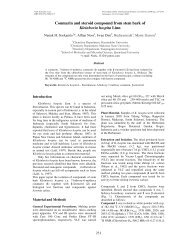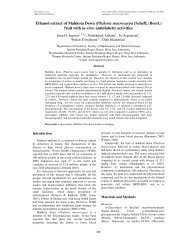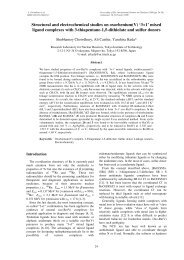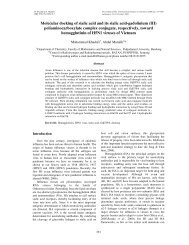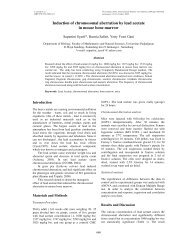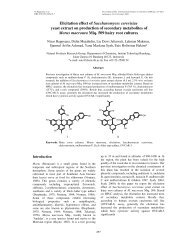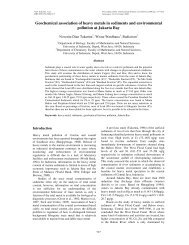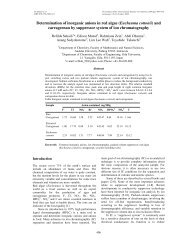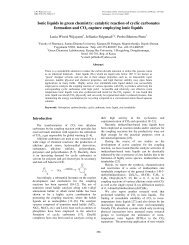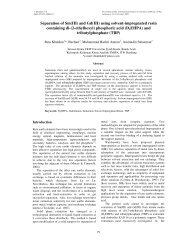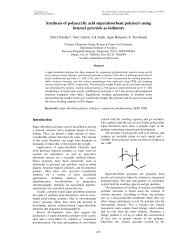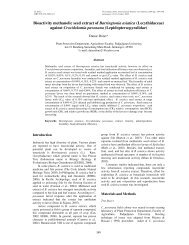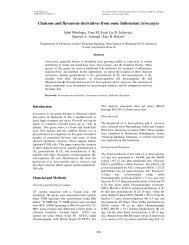Green Synthesis of C-4-Hydroxy-3-methoxyphenylcalix[4 ...
Green Synthesis of C-4-Hydroxy-3-methoxyphenylcalix[4 ...
Green Synthesis of C-4-Hydroxy-3-methoxyphenylcalix[4 ...
- No tags were found...
You also want an ePaper? Increase the reach of your titles
YUMPU automatically turns print PDFs into web optimized ePapers that Google loves.
M. Firdaus et al. Proceeding <strong>of</strong> The International Seminar on Chemistry 2008 (pp. 346-350)Jatinangor, 30-31 October 2008Solvent-free synthesis <strong>of</strong> 1The reaction was done according to the method asdescribed by Roberts et al. (2001). A mixture <strong>of</strong>vanillin (5 mmol), resorcinol (5 mmol), and p-toluenesulfonic acid (0.3 mmol) was added together ina mortar and pestle and ground vigorously. Withinseconds, a viscous paste formed which hardened onfurther grinding. The paste was left to stand for up to1 h, during which time it solidified to yield a red solid.The solid was reground, washed with water to removeany acid, filtered, and the product was recrystallizedwith hot methanol to give pink colored solid 1. m.p.>400 °C. FTIR (KBr) ν max (cm −1 ): 3425 (OH), 1612and 1512 (ArH), 3000 – 2800 and 1373 (CH 3 ), 1427(>CH−), 1033 and 1211 (OCH 3 ). 1 H NMR (500 MHz,DMSO-d 6 ) C 2h isomer δ (ppm): 8.38 (8H, s, OH A ),7.98 (4H, s, OH B ), 5.96 – 6.40 (20H, m, ArH), 5.41(4H, s, >CH−), 3.44 (12H, s, −OCH 3 ). C 4v isomer δ(ppm): 8.47 (8H, s, OH), 7.98 (4H, s, OH), 5.96 –6.40 (20H, m, ArH), 5.58 (4H, s, >CH−), 3.44 (12H,s, −OCH 3 ).Solvent-free synthesis <strong>of</strong> 2This reaction was carried out with the same procedureand condition in mol quantity as in synthesis <strong>of</strong> 1 butvanillin was replaced by p-anisaldehyde. Yield solidm.p. >400 °C. FTIR (KBr) ν max (cm −1 ): 3402 (OH),3001, 1612, and 1512 (ArH), 3000 – 2800 (CH 3 ),1427 (>CH−), 1026 and 1242 (OCH 3 ). 1 H NMR (500MHz, DMSO-d 6 ) C 2h isomer δ (ppm): 8.43 (8H, s,OH), 5.74 – 6.60 (24H, m, ArH), 5.44 (4H, s, >CH−),3.61 (12H, s, −OCH 3 ). C 4v isomer δ (ppm): 8.52 (8H,s, OH), 5.74 – 6.60 (20H, m, ArH), 5.57 (4H, s,>CH−), 3.70 (12H, s, −OCH 3 ).Results and DiscussionC–4–hydroxy–3–<strong>methoxyphenylcalix</strong>[4]resorcinarene1 and C–4–<strong>methoxyphenylcalix</strong>[4]resorcinarene 2have been prepared by a single step direct synthesisunder solvent free condition. The reaction wasachieved by simply grinding together equimolarquantities <strong>of</strong> starting materials in the presence <strong>of</strong> p-toluenesulfonic acid as the catalyst. The methodologyis simple, energy-efficient, and relatively quick. Thismethod is significantly faster than solvent-basedmethod traditionally employed in the synthesis <strong>of</strong> 1and 2 as previously reported by Sardjono (2006). Thereaction scheme for the formation <strong>of</strong> 1 and 2 ispresented in Figure 1.Solvent-free synthesis <strong>of</strong> 1Solvent-free synthesis <strong>of</strong> calix[4]resorcinarene 1from vanillin and resorcinol gave pink colored solid in52% yield having melting point >400 °C. Regardingthe theoretical atom economy, this reaction has highatom economy (93%). Unfortunately, the experimentalatom economy is only 48%. Although theexperimental atom economy is not as high as thetheoretical atom economy, this procedure is still incorridor <strong>of</strong> the green chemistry principles. Thereduced reaction time, elimination <strong>of</strong> energy neededfor heating and/or cooling, minimum quantity <strong>of</strong>catalyst, elimination <strong>of</strong> solvent and subsequent wasteare all important factors in complying with theprinciples <strong>of</strong> green chemistry.Figure 1 <strong>Synthesis</strong> <strong>of</strong> calix[4]resorcinarene 1 and 2FTIR spectrum <strong>of</strong> compound 1 shows the hydroxyl(-OH) stretching as a broad absorption at 3425.3 cm −1 .Strong absorptions at 1612.4 and 1512.1 cm −1 indicatean aromatic group. Absorption band at 3000 – 2800cm -1 together with absorption at 1373.2 cm −1 expressthe existence <strong>of</strong> Csp 3 -H from a methyl group. Theabsorption <strong>of</strong> the methine group appears at 1427.2cm −1 . Absorptions at 1033.1 cm −1 and 1211.2 cm −1indicate a C–O–C bond <strong>of</strong> methoxy bonded inunsaturated group (Sharma, 2002). There is noaldehyde absorption band <strong>of</strong> the starting material(vanillin) appeared in the spectrum. This is theevidence that the reaction had taken place. All <strong>of</strong> thefunctional groups appeared in the spectrum (Figure 2)are consistent to the structure <strong>of</strong> C–4–hydroxy–3–methoxyphenyl calix[4]resorcinarene.% TransmittanceWavenumber (cm −1 )Figure 2 FTIR Spectrum <strong>of</strong> Compound 1347



